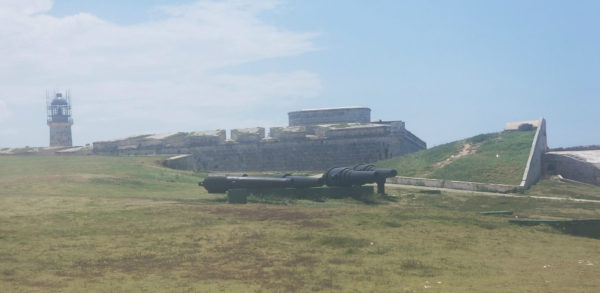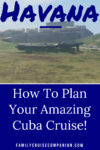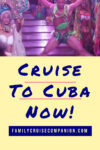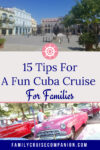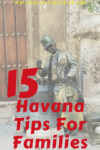Over the past few years, the opportunities for regular Americans to travel to Cuba have greatly expanded. And, one of the easiest ways to visit is by sailing a cruise that stops at the Havana cruise port. Booking a cruise can certainly simplify your travel planning, but read on a for few tips to make sure that your family gets the most out of this experience.
(2022 Note: After this article was originally published, an administration change resulted in a ban on Americans cruising to Cuba. It remains unclear whether the most recent administration change will alter that yet again.)
We recently sailed on a family cruise on Royal Caribbean’s Majesty of the Seas. The absolute highlights of the trip were our visits to the Havana cruise port! For years, I wanted to visit Cuba, but I was never eligible to go. So once it became possible for Americans to sail on cruises that stopped in Cuba, that shot to the top of my wish list. And, we were finally able to pull it off.
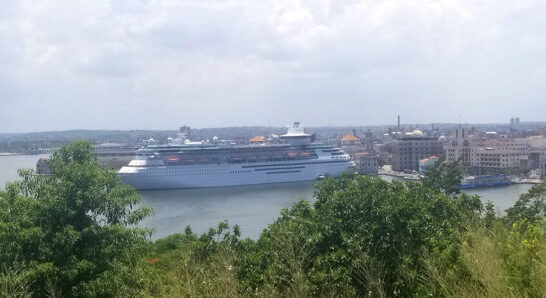
Visiting The Havana Cruise Port
Let me preface this by saying, we had a fabulous time. Everyone in our travel party ultimately enjoyed the cruise (even the family members who were forced to arrive without any luggage due to flight mishaps). And we would all do it again.
Here are 15 things that families planning a cruise to Havana should know – some good, some fair, and some watch-outs.
This post may contain affiliate links that could result in payment of a commission to this website (at no additional cost to you). Visit our Disclosures Page for more information.
1. Consider Booking Back-To-Back Cruises With Stops At The Havana Cruise Port.
At the time that we looked at booking a cruise to Cuba, the only ones we saw had relatively short itineraries of 4 or 5 days. But we usually plan our summer vacation around a 7-day cruise, so we really wanted something longer. What we ended up doing was putting together a back-to-back itinerary. We booked a 4-night and a 5-night cruise on the same ship. We kept the same staterooms, so we still had the benefit of only unpacking once.
Both legs of the cruise sailed roundtrip out of Tampa. So, for the combined 9-day itinerary, we had two different stops in Havana, plus stops in the ports of Key West and Cozumel. Also, one of the Havana stops was an overnight stop which added additional variety to the itinerary.
HOTEL TIP: TAMPA MARRIOTT WATER STREET
We flew to Tampa before our embarkation day and stayed at this wonderful, family-friendly hotel. They offered a great breakfast buffet and a speedy shuttle to the nearby cruise terminal. And, the hotel staff provided excellent service!
The original prices when we booked were very affordable compared to other Caribbean itineraries. And, we saved money booking ocean view rooms. Plus, on two occasions after we booked, our cruise specialist was able to help us take advantage of subsequent price reductions. So, overall, it was a great deal!
2. The Actual Visa Requirements and Travel Restrictions Can Be Confusing.
Americans need two important documents when sailing to Cuba. First, there’s the actual visa needed to enter the country. You can purchase those on board from the cruise line. It was $75 per person and charged to our shipboard accounts.
In addition to a visa, Americans (or those subject to U.S jurisdiction), must also comply with government regulations that restrict travel to Cuba. You cannot travel as a general tourist. (So, no bopping off to the beach.) Rather, you must fall within one of 12 recognized categories. If you are traveling by cruise ship, you will complete a certification at embarkation that identifies which bucket your trip falls into.
Also, we opted to purchase travel insurance, so we also had to complete a different version of the certification before we ever left home. Our travel insurance carrier required that we fax in copies a few months before we sailed. Interestingly, the version provided by the travel insurance company had much more descriptive detail as to the categories of authorized travel.
The Key Categories
Cruise ship passengers will most likely fall under one of two categories. Either the “people to people” category or the “support the Cuban people” category. The “people to people” category essentially requires that you participate in a tour sponsored by an authorized entity. Some of the confusion about this category likely stems from the fact that the requirements changed relatively recently, in 2017. So some of the information floating around online is no longer valid. In particular, any references you see to an ability to “self certify” under the “people to people” category is out of date.
If you book an excursion with the cruise line, you will be in full compliance with the “people to people” category.
But, you can still be in compliance even if you make excursion arrangements outside of your cruise line. The most likely applicable category would be the “support of the Cuban people” category. (This is a relevant excerpt from the certificate provided by our travel insurance company.)
Support for the Cuban people (31 C.F.R. § 515.574). […] I certify that my schedule of activities does not include free time or recreation in excess of that consistent with a full-time schedule. I also certify that the activities are of recognized human rights organization; independent organizations designed to promote a rapid, peaceful transition to democracy; or individuals and non-governmental organizations that promote independent activity intended to strengthen civil society in Cuba.
You can find more information about what “support for the Cuban people” means here at §515.574. But be aware that pure leisure activities — such as a day at the beach — do not qualify.
3. Cruise Line Excursions Aren’t Required For Visiting The Havana Cruise Port.
Because of the travel restrictions referenced above, the issue of shore excursions can be quite confusing. But know that you are not required to book shore excursions through the cruise line. And you will not be forced to remain on ship if you don’t book excursions through the cruise line. (Apparently, some travelers have been told otherwise.)
Some of the early information we received strongly suggested that we had to book a cruise-sponsored excursion or not leave the ship. And from some research in relevant internet fora, it was clear that many others were left with similar impressions. And, some people reported being expressly told as much when they would call in for additional information. But, regardless, that’s not actually true. There are certainly restrictions on what you can do based on the certification that you sign, but you can still make other arrangements beyond cruise line excursions and comply with your travel restrictions.
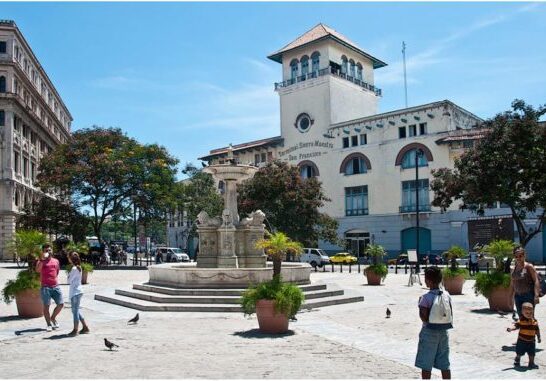
4. You Can Save Lots of Money Making Your Own Plans.
As always, we started our excursion planning by reviewing what the cruise line had to offer for the Havana cruise port. And, because of the itinerary we’d planned, we had a total of 3 days to work with for Havana excursions. Including options for evening excursions.
When we first looked at the official excursions, we had some serious sticker shock. The difference between some of the prices quoted for Havana excursions and what we typically see quoted for Caribbean excursions was truly jaw-dropping.
Official Cruise Line Version
The best example of this is the Best of Havana tour which basically was a full-day bus tour of all of the major cultural sites plus lunch. It did not include a walking tour of the pedestrian-only section of Old Havana. Nor did it include a visit to the fort (both of which were parts of separate offerings and required an additional fee). The price was $208 per person for kids and adults.
For this cruise, our travel party included 10 people — 6 adults and 4 kids. So the full day tour for our group would have been $2,080. None of the families in our group wanted to pay that much money. So, we started investigating other options.
Budget-Friendly Version
After digging through some of the reviews on TripAdvisor, we were able to find several well-reviewed alternatives. Including reviews from folks who had sailed our exact same ship and itinerary. We ultimately found a full-day private tour that was part walking tour and the remainder in an air-conditioned van. For this private full-day tour, we would be able to hit the major sites identified in the cruise line tour, and also visit Old Havana and the Fort.
This private tour with an English-speaking guide cost our group of 10 a grand total of $400. So, $2,080 to travel with a large group with a fixed agenda vs $400 for a small private tour where we pick the highlights. The $2,080 price would include lunch for our party of ten, but the $400 would not.
Even though the price did not include a meal, we were able to schedule a lunch break as part of our touring day. We ate a very nice authentic sit-down meal at a restaurant recommended by the tour guide. Our bill, including drinks and tip, was around $200. (Which still left a savings of $1400 from the cruise line excursion.)
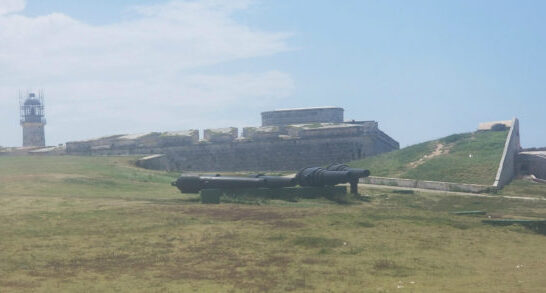
5. Take Snacks and Water. Lots of Water
Prior to stopping for the first time in Havana, the cruise director staff repeatedly instructed passengers that we should plan to take snacks with us in Havana. Either snacks purchased in Key West, or something from the ship (like dry cereal). The ship’s staff explained that you could not easily pop into a convenience store in Havana. And that we might be very sad if we didn’t plan ahead. (Check out our list of other useful items you should plan to take with you on port calls.)
We followed the advice. We basically ended up with a backpack filled with snacks between purchases in Key West and snacks grabbed on board. As it turns out, we probably would have been okay without the snacks, but we would have been miserable without the water. It was blazing hot, and we were doing lots of walking on uneven ground. We drank every drop of water that everyone in our party had, and then tracked down more.
6. An Old Havana Walking Tour Is Worth The Effort.
Much of the historical sections of Old Havana is pedestrian-only. So, most excursions that include Old Havana include some variation of a walking tour. There were definitely lots of historical and cultural sites to see including historical squares, a centuries-old cathedral, Morro Castle, and various Hemingway hot spots. And, the overall ambiance was very special and different from regular downtown. Plus, even if you have kids who aren’t that interested in hearing the historical details, the wide-open plazas are a great place to run around and blow off steam.

Plaza Vieja | 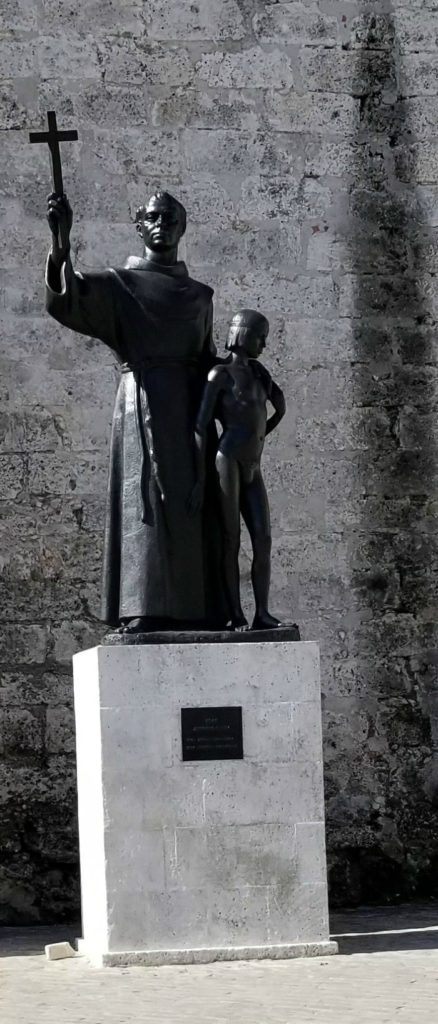
Statue of St. Francis in San Francisco Square |

Plaza de Armas | 
Presidential Train Car |
7. The Ship Docks Very Close To Old Havana.
For planning your day, know that the ship terminal for the Havana cruise port is actually walking distance from Old Havana. The square where we met our first tour guide was literally across the street from the terminal. Also, once you stepped outside the terminal, there were horse-driven taxis waiting to take you where you wanted to go.
And it is very easy to navigate back and forth. On two occasions we ended up walking back to the ship on our own.
A couple of cautions about Old Havana: Be forewarned that we encountered lots of stray dogs and cats. I am someone who gets very rattled by strays. And, I have one child who must be physically restrained from rushing off to pet every single one. You should also be aware that you may encounter aggressive panhandlers.
8. Watch for Living Statues.
When you are in Old Havana, be on the lookout for the “living” statues. They are quite the hoot. (Although some of the smaller kids in our party were afraid at first.) Basically, folks dress up in elaborate makeup and costumes designed to look like statues. Some were quite impressive. So impressive that the smaller kids were at first frightened – it was just like the Tin Man coming unexpectedly to life. They pose for pictures and they have discreet tip canisters incorporated into the costume for donations.
 | 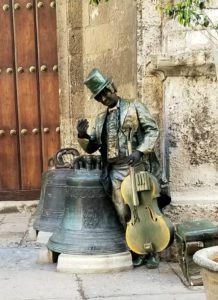 |
| A “Real” Statue | A “Living” Statue |
9. Take A Ride In The Vintage American Cars.
Havana is often described as a city frozen in time. And one reason for that is the many vintage American cars from the 60s-ish era. And, some popular excursions revolve around touring in such cars. We actually had the opportunity to sit in a car and take pictures during our private tour. And, after doing that, we decided to book a separate tour that included riding around in one.
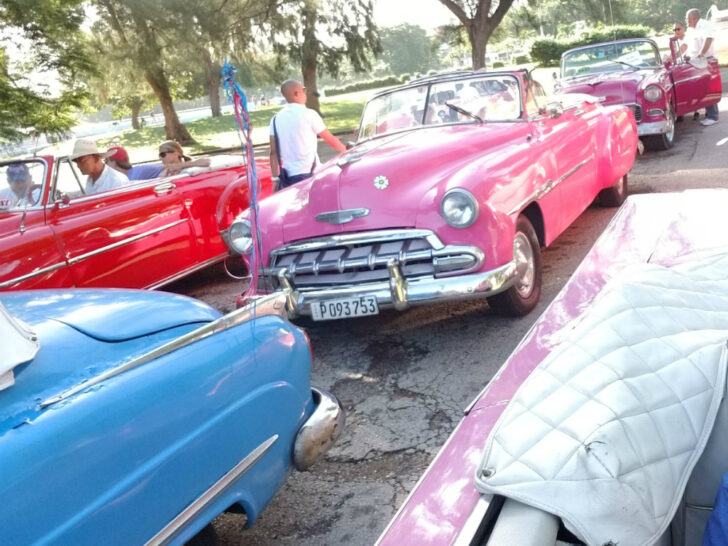
This excursion sounded fun on paper, and ended up being even more fun than we imagined. The kids absolutely loved it. All of the vintage cars that participated in this tour were convertibles. So, we were able to drive around with the top down taking in all of the sites and cruising by the ocean.
The organized excursion included a one-hour car ride (although it ended up being more than an hour) plus a 2-hour bus tour and a stop for drinks at a famous hotel bar. The pricing for the whole excursion was based on per car. Even though the brochure said that there was a limit of 3 guests per car, when we asked, we were told that taking 4 guests when two of them were kids would be fine. The price per car was $289. The entire excursion was 5 hours.
10. If You Overnite In The Havana Cruise Port, Visit A Cabaret.
During the overnight stop, we also booked an evening cabaret show excursion through the cruise line. Now, this is one where we could have saved quite a bit of money if we had booked it ourselves directly with the venue. But overall, for this one, it seemed like the value favored the more expensive cruise line version. We were guaranteed reserve seating. And, we had roundtrip transportation. Which means we didn’t have to worry about wandering around Havana at night trying to catch a cab.
 |  |
The cabaret show was definitely worth the effort. It was simply spectacular. We did one of the alternatives to the famous Tropicana, and it was still fabulous. Specifically, we chose the Cabaret Parisien located in the Hotel Nacional.
(This is probably obvious, but we did not take our children to the show. This was one of those times when it was best to leave the kids on the cruise ship in port. But they had a great time of their own at the kids’ club).
11. Be Prepared For Long Waits At the Havana Cruise Port Getting On And Off The Ship.
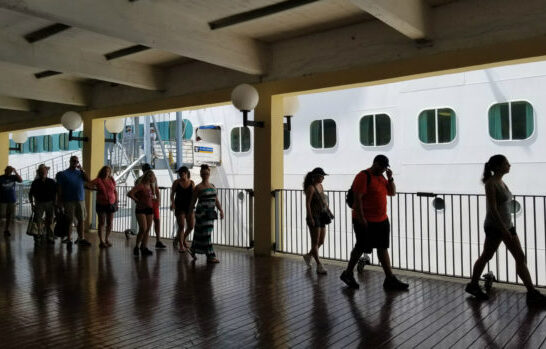
Be prepared for long lines and long overall transit times for getting off of and onto the ship. When it was time to disembark, passengers were sent to a designated waiting area on the ship, and they would release people in chunks to try and control the crowd and waiting outside. But even with that control measure, it was still a very long line. The days that we were there, the Cuba immigration officials had numerous lines open, but it was just a slow process.
Once you exited the ship and entered the terminal, you stood in a line to show your passport and submit your visa. And all papers were carefully inspected. Then you went through a metal detector. There was also a long line to exchange currency. We ended up having one person stand in line and change everyone’s money.
This whole process had to be repeated in reverse when time to return to the ship. You also go back through a metal detector and pass through immigration on your way back to the ship. (This was different from the security screening on board the ship.) And, again, there was a long line to get back on the ship. This line seemed to move the slowest of all. Perhaps because of the additional metal detector screening once you stepped on the ship. But it was the end of the day so I’m sure the tiredness factor was part of it.
We followed the same process when we got off the ship for our nighttime excursion. But, the process through immigration seemed to move much faster even though they had less people.
12. Cuba Has Special Tourist Currency And A Surcharge for American dollars.
Cuba has a separate currency for tourists. And there is an additional surcharge for changing U.S. dollars into tourist dollars as opposed to any other currency. We were told that the surcharge was 10%. So, depending on the amount of currency you think you will be changing, it could be worth it to investigate getting Euros or Canadian dollars before you go. For us, the rough math didn’t warrant the hassle of tracking down Euros or Canadian currency in advance.
13. Rum And Cigars
Cuba is known for its cigars and rum. And, you’re allowed to bring both of these items back into the United States. Although you will see cigars sold through street vendors, it’s widely recommended that you purchase through the official government store only. So that you know what you’re getting. And, interestingly enough, both our private tour guide and the tour guide with the cruise sponsored tour both took us to the same store in Old Havana.
Keep in mind that many people want to get rum and cigars. Both times that we went, there was a very large crowd. And, it was not well organized. You kind of had to “assert” your place in line and make sure you kept it.
On the positive side, the store had a cafe with tables and chairs upstairs, so the kids were able to sit down and chill while the interested adults made purchases.
14. Public Toilets & Toilet Paper.
You are not supposed to flush toilet paper down the toilet in Cuba. You’re supposed to dispose of it in the trash receptacle adjacent to the toilet. This is not uncommon in several Latin American countries. I only make note of it specifically because this fact was not well announced or consistently announced. And, several times we encountered places where the toilets were not working because they had become clogged with toilet paper.
Also, we had been tipped off that it can sometimes be hard to find toilet paper in public restrooms. So, I grabbed a box of tissues from our stateroom for our day bag. And this turned out to be a good thing. At one of the pit stops during one tour, my box of tissues ended up being passed down the long line of folks waiting for the ladies room.
15. The Flea Market
Another great stop to include is the Almacenes San Jose market. It’s near the waterfront and walking distance from the Havana cruise port terminal. This is basically a very large indoor flea market. You will find numerous stalls selling impressive artwork that’s reasonably priced. Also, lots of handmade leather goods, ceramics, and a variety of souvenirs such as t-shirts, magnets, etc. Note that the market is not air-conditioned, and it can get very hot as you’re walking through the stalls. Also, be aware that if you purchase art, you will be assessed an export tax as you leave Havana. Customs officials pulled people to the side when they spotted the rolled tubes.

Elaine Warren
Founder & Crew Chief
Elaine founded this website after publishing the book The Family Cruise Companion’s Guide to Cruising With Kids. (Second edition recently released!) She has sailed on 45 cruises (and counting). She loves helping families navigate their way to an adventure-filled, fun, and memorable vacation.

